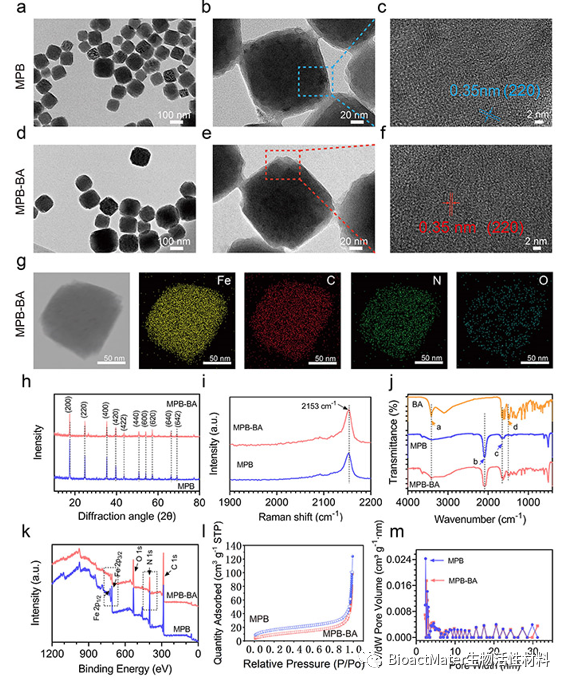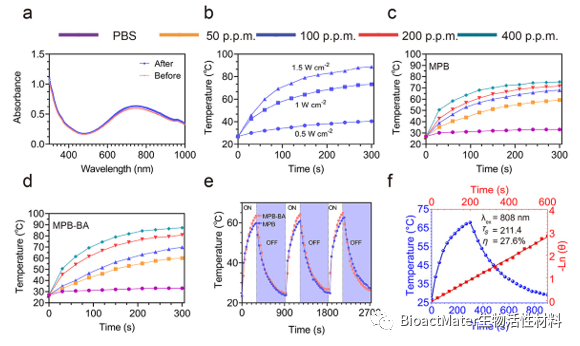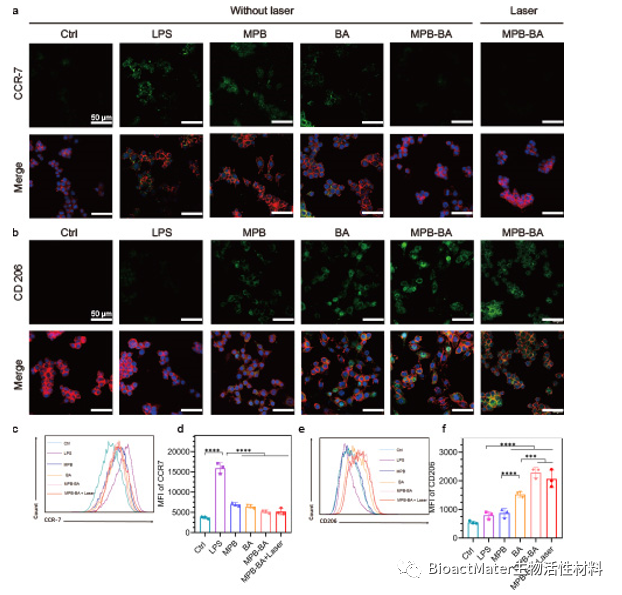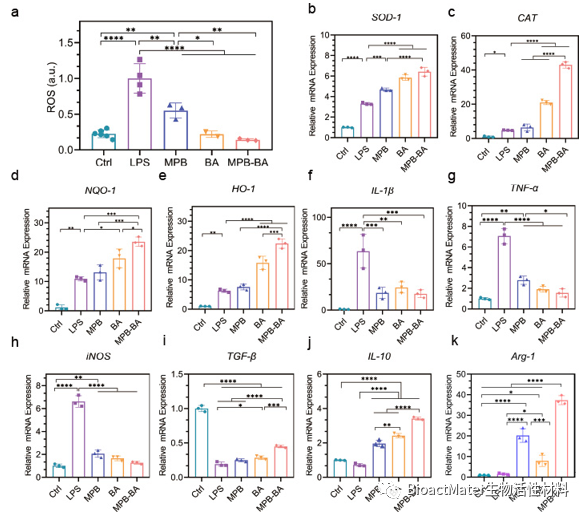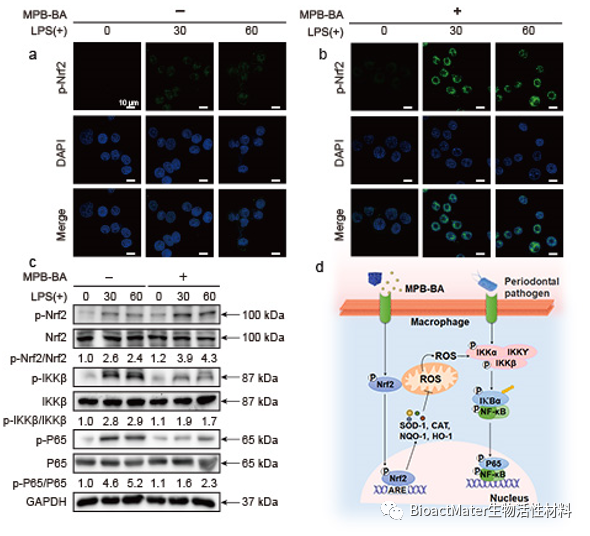天津大学吴水林团队构架介孔普鲁士蓝装载黄芩素的抗菌策略
时间:2022-02-25 14:44:33 来源:BioactMater生物活性材料 点击量:
牙周炎是世界第六大流行病,是一种由细菌诱导的宿主炎症性疾病,现有治疗通常采用机械清除生物膜辅以局部或全身应用抗生素的方法,存在着产生细菌耐药性的潜在风险;另一方面兼具抗菌、抗炎作用的药物较少。本研究采用介孔普鲁士蓝(mesoporous Prussian blue, MPB)装载黄芩素(baicalein, BA)构建一种兼具抗菌和抗氧化、抗炎功能的纳米材料(MPB-BA),并进行机制研究。该材料在近红外光照射下,通过光热作用协同抗菌药物显著抑制牙周致病菌感染;同时,一方面清除炎症局部过量的活性氧(Reactive oxygen species, ROS)及上调抗氧化酶的表达,发挥抗氧化作用;另一方面抑制巨噬细胞向M1型转化,促进其向M2型转化,发挥抗炎功效。其分子机制为促进Nrf2磷酸化,抑制NF-κB表达,经由调控抗氧化抗炎通路,以缓解氧化应激反应,减轻过度炎症,阻断牙周组织损伤,实现快速治疗牙周炎。
01研究内容简介
牙周炎是一种慢性炎症性疾病,影响全球约 10% 的人口。它由牙周细菌感染引发,随后因过度宿主免疫反应而加重。如果不及时有效治疗,牙周炎会导致牙周软组织退缩、牙槽骨吸收,甚至牙齿脱落,极大地降低生活质量。此外,牙周炎与糖尿病、阿尔茨海默病、心血管疾病、早产、类风湿性关节炎、慢性肾病、癌症等全身性疾病的进展密切相关。因此,开发一种快速有效的策略来缓解炎症是治疗细菌性牙周炎的核心。
临床上,牙菌斑主要通过机械方法辅助使用抗生素进行清除。由于近年来滥用抗生素引起细菌耐药性,迫切需要新的替代性抗菌策略。同时,在牙周炎的发病机制中,氧化应激是不可分割的一部分。炎症部位过量的 ROS 会维持炎症微环境以促进巨噬细胞向 M1 表型转化,并使其释放促炎细胞因子和 ROS,形成恶性循环,加剧炎症。此外,过量的ROS能够直接致使细胞脂质过氧化,并破坏蛋白质和DNA,导致牙周组织的氧化损伤,影响牙周组织再生。因此,使用清除 ROS 以减轻过度炎症被认为是阻断牙周炎进展的有效方法。
目前大多数治疗牙周炎的药物以单一的对抗牙菌斑为主,现有研究中兼具抗菌、抗炎作用的药物较少。在本研究中,我们以快速去除牙周致病菌、清除ROS、缓解炎症为目标,采用MPB纳米颗粒装载BA(二者均为美国食品和药物管理局批准的药品),合成了具有抗菌、抗氧化抗炎功能的MPB-BA,他可以通过光热治疗(Photothermal therapy, PTT)清除牙周致病菌,协同调控Nrf2/NF-κB信号通路治疗牙周炎(Scheme 1)。
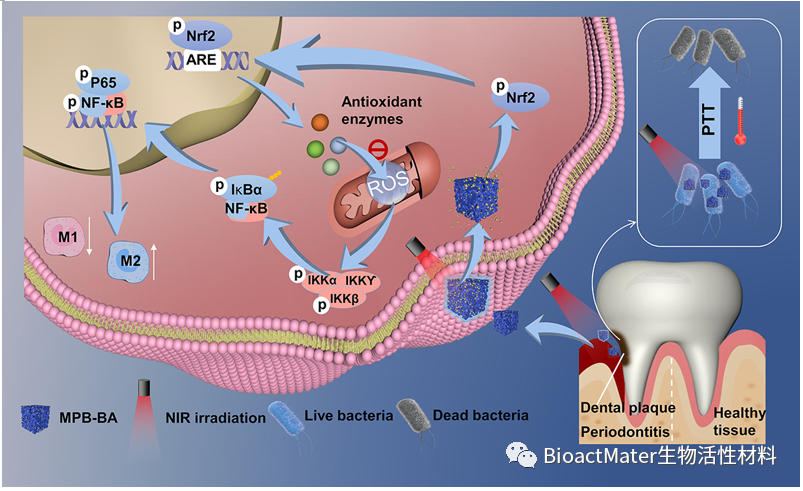
Scheme 1. Schematic illustration of antioxidant, anti-inflammatory mechanism and antibacterial effects of MPB-BA nanozyme in the treatment of periodontitis.
首先,我们在MPB基础上制备MPB-BA,通过对MPB-BA进行相关表征,证明BA成功负载于MPB的介孔中(Fig. 1)。
Fig. 1. Characterization of MPB and MPB-BA. (a) TEM picture of MPB, scale bar = 100 nm. (b) High-resolution TEM image of (a), scale bar = 20 nm. (c) High-resolution TEM images of the blue square shown in (b), scale bar = 2 nm. The crystal lattice planes and interplanar spacing of MPB were displayed in (c). (d) TEM picture of MPB-BA, scale bar = 100 nm. (e) High-resolution TEM image of (d), scale bar = 20 nm. (f) High-resolution TEM images of the red square shown in (e), scale bar = 2 nm. The crystal lattice planes and interplanar spacing of MPB-BA were displayed in (f). (g) Elemental mapping images of MPB-BA. (h) XRD patterns of MPB and MPB-BA. (i) Raman of MPB and MPB-BA. (j) FTIR of BA, MPB, and MPB-BA. (k) Total peaks of XPS of MPB and MPB-BA. (l) N2 adsorption (filled symbols) and desorption (open symbols) of MPB (blue) and MPB-BA (red). (m) Pore size distribution profiles of MPB (blue) and MPB-BA (red).
进一步,我们对MPB-BA的光热性能进行检测。通过一系列实验证实,MPB-BA可以在体外稳定地发挥光热作用,且具有良好的光热稳定性(Fig. 2)。
Fig. 2. Photothermal properties of MPB-BA. (a) UV–vis–NIR spectroscopy of MPB-BA (100 p.p.m.) before and after laser irradiations for three cycles. (b) Photothermal curves of MPB-BA (100 p.p.m.) irradiated by different laser intensity (0.5, 1, and 1.5 W cm-2) for 5 min. Photothermal curves of MPB (c) and MPB-BA (d) with various concentrations (50, 100, 200, and 400 p.p.m.) after laser irradiation (1 W cm-2) for 5 min. (e) Recycling heating profiles of MPB and MPB-BA under laser irradiation (1 W cm-2) for three cycles. (f) Photothermal conversion efficiencies (η) of MPB-BA by laser irradiation for three cycles. Blue line: photothermal effect. Red line: time constant (τs) of the cooling period by using the linear time data.
我们进一步探究MPB-BA在近红外光(Near infrared light, NIR)照射下,BA的释放规律,结果显示在NIR照射下,光热作用能够促进BA释放;同时,MPB-BA体外拟抗氧化酶活性检测证实MPB-BA具有清除ROS活性 (Fig. 3)。
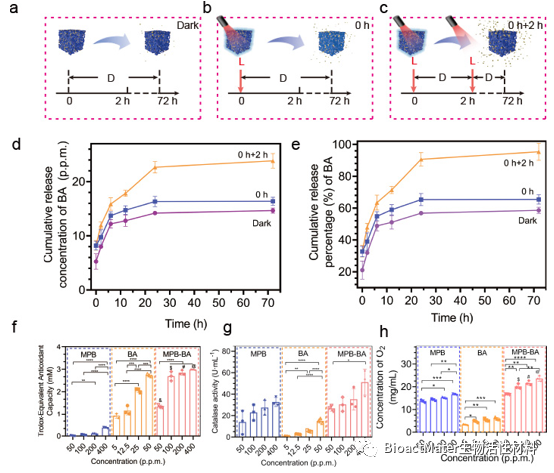
Fig. 3. NIR-controlled release of BA from MPB-BA and scavenging ROS activities of MPB-BA. (a-c) Diagrams of photothermal-controlled release performance of BA in different groups (D: dark; L: light). The subjects were distributed into 3 groups: 72-hour darkness (Dark Group); 0-hour-point irradiation (15 min), 15-min-point to 72-hour darkness (0 h Group); 0-hour-point irradiation (15 min), 15-min-point to 2-hour darkness, 2-hour-point irradiation (15 min), darkness until 72-hour (0 h+2 h Group). (d) Cumulative release concentration curves of BA in different groups. (e) Cumulative release percentage curves of BA in different groups. (f) Total antioxidant activity of MPB (50, 100, 200, and 400 p.p.m.), BA (5, 12.5, 25, and 50 p.p.m.) and MPB-BA (50, 100, 200, and 400 p.p.m.). (g) CAT-like activity of MPB, BA and MPB-BA. Error bars indicated means ± standard deviations (n = 3 biologically independent samples). * P < 0.05, **P < 0.01, ***P < 0.001, ****P < 0.0001; one-way analysis of variance (ANOVA) with Dunnett’s multiple comparisons test. & denotes the statistical significance between MPB-BA 50 p.p.m. and MPB 50 p.p.m. (&P < 0.0001). $ denotes the statistical significance between MPB-BA 100 p.p.m. and MPB 100 p.p.m. ($P < 0.0001). # denotes the statistical significance between MPB-BA 200 p.p.m. and MPB 200 p.p.m. (#P < 0.0001). @ denotes the statistical significance between MPB-BA 400 p.p.m. and MPB 400 p.p.m. (@P < 0.0001).
我们在体外模拟炎症环境,探究MPB-BA能否抑制巨噬细胞的促炎状态。结果显示,MPB-BA处理组能够抑制巨噬细胞向M1型(CCR-7)转化,促进其向M2型(CD 206)转化(Fig. 4)。
Fig. 4. The effects of MPB-BA on macrophage polarization. Representative immunofluorescence images for CCR-7 (a, green) and CD206 (b, green) in macrophages cultured with different materials, scale bar = 50 μm. Flow cytometry results of macrophages cultured with various materials for CCR-7 (c) and CD206 (d). Quantitative analyses of the flow cytometry results of CCR-7 (e) and CD206 (f), n =3. Error bars indicated means ± standard deviations. ***P < 0.001, ****P < 0.0001; one-way analysis of variance (ANOVA) with Dunnett’s multiple comparisons test.
接下来,我们检测MPB-BA对体外炎症环境中过量ROS的清除能力。结果显示,MPB-BA能够显著清除炎症细胞内过量的ROS(Fig. 5a);进一步探究了MPB-BA对胞内清除ROS的抗氧化酶表达的影响,结果显示,MPB-BA可以促进炎症状态下抗氧化酶SOD-1, CAT, NQO-1,和HO-1的表达,从而清除过量的ROS(Fig. 5b-e);同时,我们检测了MPB-BA对炎症状态下巨噬细胞炎症因子表达的影响,结果显示MPB-BA可以抑制促炎因子IL-1β, TNF-α, 和 iNOS的表达, 促进抑炎因子TGF-β, IL-10, 和 Arg-1的表达(Fig. 5f-k)。
Fig. 5. In vitro antioxidant and anti-inflammatory effects of MPB-BA. (a) Intracellular ROS scavenging capacity of MPB (100 p.p.m.), BA (25 p.p.m.), and MPB-BA (100 p.p.m.) using DCFH-DA test. (b-e) displayed the mRNA levels of four antioxidant enzyme genes, SOD-1, CAT, NQO-1, and HO-1 determined by qRT-PCR. (f-k) revealed the mRNA levels of pro-inflammatory genes IL-1β, TNF-α, iNOS (f-h) and anti-inflammatory genes TGF-β, IL-10, Arg-1 (i-k), n =3. Error bars indicated means ± standard deviations. *P < 0.05, **P < 0.01, ***P < 0.001, ****P < 0.0001; one-way analysis of variance (ANOVA) with Dunnett’s multiple comparisons test.
核转录因子类红细胞 2 相关因子2 (Nrf2) 是调节氧化应激的主要因子。我们进一步探究MPB-BA对Nrf2的表达的影响;结果显示MPB-BA可以促进巨噬细胞内部Nrf2磷酸化及入核,从而下调氧化应激反应。已有研究显示,过量ROS会激活NF-κB炎症通路。结果表明,MPB-BA通过抑制IKKβ和P65的磷酸化从而抑制NF-κB通路以缓解炎症(Fig. 6)。
Fig. 6. In vitro antioxidant and anti-inflammatory mechanism evaluation of MPB-BA. Representative immunofluorescence images for p-Nrf2 (green) in macrophages incubated without (a) or with (b) MPB-BA before LPS treatment (0, 30, and 60 min). Nuclei were stained with DAPI (blue), scale bar = 10 μm. (c) Western blot detection of p-Nrf2, Nrf2 and p-IKKβ, IKKβ, p-P65, P65 (NF-κB inflammatory pathway), with GAPDH as the internal control. (d) The antioxidant and anti-inflammatory mechanism of MPB-BA was presented as a schematic diagram.
我们利用转录组学分析MPB-BA体内治疗牙周炎的机制。结果显示, MPB-BA治疗牙周炎的潜在机制与增强氧化还原酶活性、抑制NF-κB炎症通路、上调抗氧化基因、抑制促炎因子分泌密切相关(Fig. 7)。
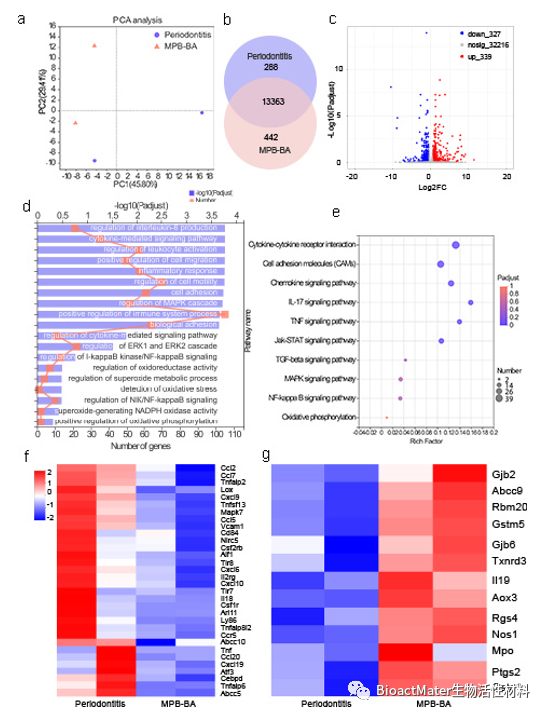
Fig. 7. In vivo therapeutic mechanism of MPB-BA for periodontitis. (a) Principal component analysis (PCA) was performed based on differentially expressed genes from the gingival tissue of periodontitis and MPB-BA groups. Each point represented one sample. PCA plot showed the obvious separated gene expression between periodontitis and MPB-BA groups. (b) Venn diagram of differentially expressed genes of periodontitis and MPB-BA groups. (c) Volcano plots showed the identified upregulated and downregulated genes by MPB-BA. (d) Significantly enriched GO terms for genes in the MPB-BA group compared with the periodontitis group. (e) KEGG pathway analysis for the identified differentially expressed genes. (f) Downregulated pro-inflammatory genes after MPB-BA treatment (fold change ≥ 1.5 and P < 0.05). (g) Upregulated antioxidant-related genes after MPB-BA treatment (fold change ≥ 1.5 and P < 0.05).
体内实验显示,与临床常用的抗菌药物相比,MPB-BA显示出更佳的抗炎效果,能够通过上调p-Nrf2表达,抑制p-P65表达来减轻牙周炎;同时MPB-BA也表现出抑制骨吸收的效果(Fig. 8)。
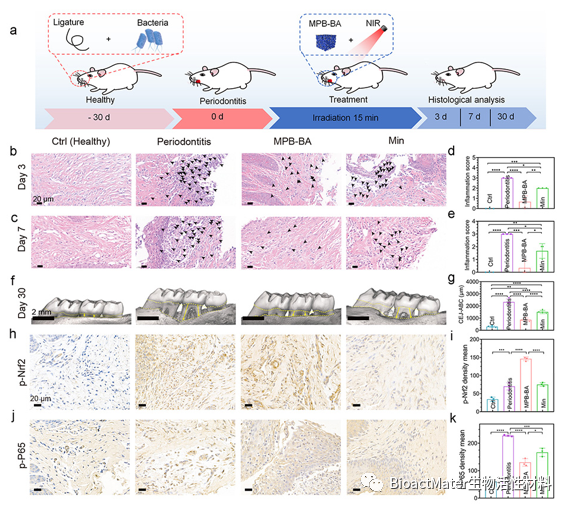
Fig. 8. In vivo therapeutic efficacy of MPB-BA in periodontitis rats. (a) Schematic diagram of experimental design. MPB-BA group is treated by MPB-BA and irradiated by 808 nm NIR light for 15 min. Min group is treated by a common clinical antibiotic minocycline hydrochloride. H&E staining of the periodontal tissues after 3 (b) and 7 days (c) of treatment. Black arrows indicate inflammatory cells, scale bar = 20 μm. Semi-quantitative assessment of inflammatory cells in images of H&E staining after treatment for 3 days (d) and 7 days (e). (f) Micro-CT reconstructed images of the maxillary molar area, scale bar = 2 mm. (g) The distance between the cement-enamel junction (CEJ, yellow dotted line on the top) and the crest of alveolar bone (ABC, yellow dotted line at the bottom) was measured for the first molar and second molar. (h) Immunohistochemical images of p-Nrf2 from different groups, scale bar = 20 μm. (i) The corresponding quantitative analysis of p-Nrf2 in different groups. (j) Immunohistochemical images of p-P65 from different groups, scale bar = 20 μm. (k) The corresponding quantitative analysis of p-P65 in different groups. Error bars indicated means ± standard deviations (n = 3 biologically independent samples). *P < 0.05, **P < 0.01, ***P < 0.001, ****P < 0.0001; one-way analysis of variance (ANOVA) with Dunnett’s multiple comparisons test.
综上所述,本研究基于生物安全材料,提出光热及免疫治疗协同作用清除细菌感染并减轻牙周炎症的策略。我们成功制备了MPB-BA纳米平台,证实MPB-BA可以通过光热协同抗菌药去清除牙周致病菌;通过上调Nrf2通路,清除ROS,从而抑制NF-κB 炎症通路缓解过度的炎症反应。本研究为牙周炎症的抗菌抗炎治疗提供了新的治疗策略和理论基础。
02论文第一/通讯作者简介
第一作者:田雨娟
博士研究生、天津医科大学、研究方向为纳米药物研发,通过光控抗菌和免疫调控治疗牙周炎和相关机制研究,种植体表面改性促进骨结合和软组织封闭的机制研究。
通讯作者:李莺
天津医科大学口腔医院主任医师、副教授、硕士生导师,2001年毕业于四川大学华西口腔医学院,获得硕士学位;2011年毕业于日本大学,获得博士学位。主要研究方向:基于学科交叉和理工医学相结合,开展口腔种植材料和牙周药物研发与转化,通过调控种植体和牙周免疫和炎症微环境,促进抗菌、抗炎、种植体骨结合和软组织结合以及牙周软硬组织再生的机制研究。主持完成国家自然科学基金1项,参与国家级项目3项,发表论文30余篇,其中SCI论文20余篇,获国家发明专利授权2项,培养硕士研究生10 余名。
通讯作者:吴水林
天津大学材料科学与工程学院教授,博士生导师、国家杰出青年基金获得者。2007年博士毕业于香港城市大学。主要从事医用金属材料表面改性、智能响应抗菌材料、中药材料学及其对细菌感染疾病的治疗研究。已经以通讯作者或共同通讯在Chemical Society Reviews,Matter,Nature Communications, Science Advances, Advanced Materials, JACS, ACS Nano等期刊上发表SCI 论文100余篇,被引用超过10000余次,授权中国发明专利20项。先后主持科技部973前期研究专项、国家优秀青年基金、国家基金面上项目以及国家重点研发计划课题等。
通讯作者:李长义
天津医科大学口腔医院院长,主任医师、教授、博士生导师,中华口腔医学会常务理事,中华口腔医学会口腔修复专委会副主任委员,中华口腔医学会口腔材料专业委员会副主任委员。以学科交叉为特色,开展口腔种植界面材料研发与转化,主要从事口腔种植界面材料调节宿主免疫和构建支架与再生膜促成骨、加载多肽促软组织封闭、调控微环境抗菌,揭示关键调控机制的基础和临床转化研究,主持国家自然科学基金面上项目3项,发表论文100余篇,其中SCI收录论文30余篇,获中国国家发明专利授权3项,主编及参编教材与专著8部,培养博、硕士研究生60 余名。
03资助信息
该研究得到了国家杰出青年科学基金(51925104),国家自然科学基金(81870809, 81500886, 31470920),天津自然科学基金(16JCYBJC28700),天津市卫生科技(ZD20021)等项目的支持。
04原文信息
Yujuan Tian#, Ying Li,* Jialin Liu, Yi Lin, Jian Jiao, Bo Chen, Wanmeng Wang, Shuilin Wu,* Changyi Li*
Photothermal therapy with regulated Nrf2/NF-κB signaling pathway for treating bacteria-induced periodontitis.
Bioactive Materials, 9, (2022) 428-445.
 Scheme 1. Schematic illustration of antioxidant, anti-inflammatory mechanism and antibacterial effects of MPB-BA nanozyme in the treatment of periodontitis.
Scheme 1. Schematic illustration of antioxidant, anti-inflammatory mechanism and antibacterial effects of MPB-BA nanozyme in the treatment of periodontitis.